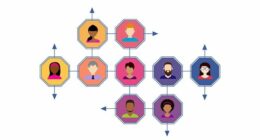Convergent and divergent thinking are two opposite ways of approaching problems. Convergent thinking is when you focus on one solution and try to find the best answer. Divergent thinking is when you explore multiple solutions and try to find the most creative answer.
What is the difference between convergent and divergent thinking?
Convergent thinking and divergent thinking are two different types of thinking that people use to approach problem-solving and creative thinking in different ways.
Convergent thinking is a type of thinking that involves focusing on finding the single best solution to a problem. This type of thinking involves narrowing down ideas and possibilities to find the most appropriate or effective answer. Convergent thinking typically involves logical and analytical thinking and is often used in situations where there is a clearly defined problem or goal.
Divergent thinking, on the other hand, is a type of thinking that involves generating multiple ideas and possibilities in response to a problem or question. This type of thinking involves broadening the range of possibilities and exploring different perspectives, and can often involve creativity and brainstorming. Divergent thinking is often used in situations where there are multiple potential solutions or where the problem or goal is not clearly defined.
In summary, convergent thinking is about finding the best solution, while divergent thinking is about generating multiple possibilities. Both types of thinking have their own strengths and weaknesses, and can be used in different situations depending on the nature of the problem or goal at hand.
Examples of convergent and divergent thinking
Convergent thinking is the ability to focus on a single task or problem and find the best solution. This type of thinking is often used in standardized tests or when solving a Math problem. Divergent thinking, on the other hand, is the ability to come up with multiple solutions to a single problem. This type of thinking is often used in creative tasks such as coming up with new ideas for a product or service.
How do these two terms apply to different areas of study?
There are a few key areas in which the terms convergent and divergent apply. In general, convergent thinking is associated with more traditional, logical approaches to problem solving, while divergent thinking is associated with more creative, out-of-the-box approaches. Here are a few specific examples:
Academic fields: In the academic world, convergent thinking is often valued more highly than divergent thinking. This is because convergent thinking lends itself more to tangible results, such as getting the correct answer on a math test or writing a clear and concise essay. Divergent thinking, on the other hand, is often seen as less useful in academic settings since it doesn’t always lead to clear-cut answers.
Business: When it comes to business, both convergent and divergent thinking have their place. Convergent thinking is often important for tasks such as analyzing data and coming up with practical solutions to problems. However, divergent thinking can be just as valuable in business contexts – especially when it comes to generating new ideas and brainstorming creative solutions to challenges.
Art: In the world of art, creativity and originality are often prized above all else. As such, divergent thinking is usually seen as more important than convergent thinking in this context. That said, there is still a place for convergent thinking in the art world – especially when it comes to perfecting technical skills or executing a pre-planned design.
When to use convergent thinking
(Image by Gerd Altmann from Pixabay )

There are many times in life when it is useful to use convergent thinking. When you need to find a single answer to a well-defined problem, convergent thinking is the way to go. This type of thinking is also useful when you need to come up with a plan or make a decision based on a set of specific criteria.
When to use divergent thinking
(Image by mohamed_hassan from Pixabay )

Divergent thinking is a thought process used to generate creative ideas by exploring many possible solutions. It is often used when a problem cannot be solved with traditional thinking or when there is no single right answer.
Divergent thinking is helpful when you need to generate new ideas, when you are stuck on a problem, or when you need to come up with multiple solutions to a single issue. This type of thinking can also be helpful in brainstorming sessions.
The Advantages and disadvantages of convergent thinking
Advantages of Convergent Thinking:
- Efficient problem-solving: Convergent thinking can be very effective in situations where a clear solution or answer is needed, as it helps to narrow down ideas and possibilities quickly and efficiently.
- Logical and analytical: Convergent thinking involves logical and analytical thinking, which can be helpful in situations that require objective analysis and evaluation.
- Measurable outcomes: Convergent thinking often leads to clear, measurable outcomes, making it easier to assess the success of a particular solution or approach.
Disadvantages of Convergent Thinking:
- Limited creativity: Convergent thinking can be restrictive and limit creativity, as it tends to focus on finding a single best solution rather than exploring multiple possibilities.
- Narrow perspective: Convergent thinking may lead to a narrow perspective on a problem or situation, as it tends to focus on finding the most obvious or practical solution rather than exploring alternative perspectives or ideas.
- Missing unexpected solutions: Convergent thinking can also be limiting in situations where the problem or goal is not well-defined, as it may miss unexpected solutions or approaches that don’t fit within the usual parameters.
Convergent thinking can be very effective in situations where a clear solution is needed, it may be less helpful in situations that require creativity, flexibility, or an open-ended approach.
The Advantages and disadvantages of divergent thinking
Advantages of Divergent Thinking:
- Creativity and innovation: Divergent thinking can foster creativity and innovation by encouraging people to explore multiple perspectives and ideas, which can lead to new and unconventional solutions.
- Broad perspectives: Divergent thinking can help to broaden perspectives and encourage exploration of new or alternative approaches to a problem or situation.
- Flexibility: Divergent thinking can be very flexible, as it does not rely on predetermined solutions or ideas and can adapt to changing circumstances or goals.
Disadvantages of Divergent Thinking:
- Time-consuming: Divergent thinking can be time-consuming and may require a significant amount of exploration and experimentation before a viable solution or approach is found.
- Lack of focus: Divergent thinking can be less focused than convergent thinking, which may make it more difficult to identify and pursue a clear solution or goal.
- Lack of feasibility: Divergent thinking can generate a lot of creative and innovative ideas, but not all of them may be feasible or practical to implement in the real world.
In summary, while divergent thinking can be very effective in generating new ideas and perspectives, it may also be less practical or efficient than convergent thinking, particularly in situations where a clear solution or goal is needed. However, both types of thinking can be useful in different contexts and can complement each other in problem-solving and decision-making processes.
What is the difference between convergent and divergent boundaries?
Convergent boundaries are where two plates collide. The collision can be caused by the ocean floor pushing up against the continental plate. This type of boundary can also form when two plates slide past each other. The force of the collision creates a subduction zone.
Divergent boundaries are where two plates move away from each other. The force that pulls them apart is called extensional force. This type of boundary forms rift valleys.
What is the difference between the two types of speciation?
There are two main types of speciation: convergent and divergent. Convergent speciation occurs when two populations of different species come into contact and begin to mate, resulting in a new hybrid species. Divergent speciation occurs when there is a change in the environment that results in one population becoming isolated from the other, eventually leading to the formation of two new, distinct species.
What is divergent in biology?
In biology, divergence is the process by which two or more lineages evolve from a common ancestor. This process can result in the formation of new species, as well as changes within existing species. Divergence typically occurs when there is a change in the environment that leads to different selection pressures on different groups of individuals. Over time, this can lead to the accumulation of genetic differences between the groups, and eventually to speciation.
What are the two models of speciation?
Convergent evolution is when two different species acquire the same or similar traits through their independent evolution. For example, both sharks and dolphins have streamlined bodies and fins that allow them to swim quickly through water. This similarity is due to convergent evolution, as both groups of animals independently developed these features to help them survive in their aquatic environments.
Divergent evolution is when two different species evolve from a common ancestor and become increasingly dissimilar over time. For example, human beings and chimpanzees share a common ancestor, but over the course of millions of years of divergent evolution they have become quite different. Humans walk upright on two legs, while chimpanzees walk on all fours; humans have smaller noses and much larger brains than chimpanzees; and humans can speak, while chimpanzees cannot.
What are the 3 types of speciation?
There are three types of speciation: Allopatric, Peripatric, and Sympatric.
Allopatric speciation occurs when two populations of a species are geographically isolated from each other and unable to interbreed.
Peripatric speciation occurs when a small group of individuals from a population become isolated from the rest of the population.
Sympatric speciation occurs when two populations of a species occupy the same geographic area but do not interbreed because they have different mating preferences or behaviors.
Featured Image By – Image by Arek Socha from Pixabay








